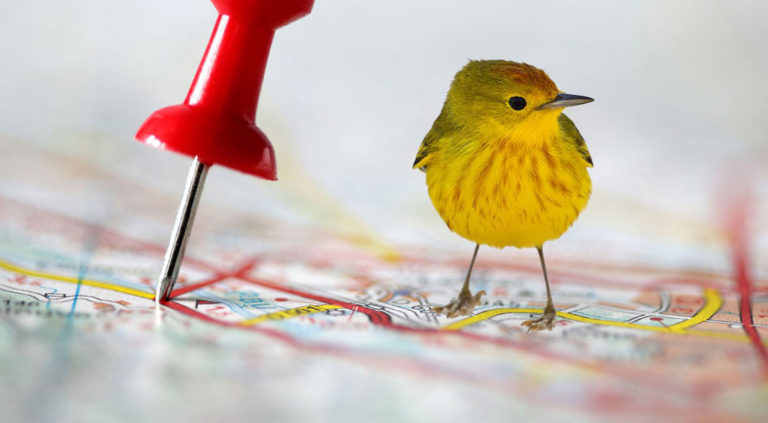eBird makes it easy to find birds no matter where you are, even if you are in a new city or location.
One of the best and most useful tools you can have in your birder’s toolkit is the knowledge of how to use eBird. Once you have mastered the art of eBird you will know the hottest and best places to go birding, no matter where you may travel!
First things first, make an account.
Why create an account? If for no other reason than to contribute to citizen science. When a new birder or an experienced birder creates an account on eBird, and enters the birds they see and where they see them, this crucial data becomes available to universities, biologists, conservation groups, land developers, you, me—anyone! Birders all over the country upload their sightings and it makes it possible to track migration patterns/timing, population fluctuations, breeding info, and more. The data made possible through eBird has countless applications that will ultimately help conserve and protect birds everywhere.
The other reason most people create an account is to start establishing a “life list.” A life list is a running count of every bird species someone has seen in their life (or since they started keeping track). Tracking statistics like this on eBird is easy. They’ll break the numbers down by month, year, location etc.
The data
There are multiple ways to view the data on eBird: view a location, view a hotspot, search for specific species within range & point maps, view bar charts, view line graphs, and watch a live submission map.
Explore a Location

After logging into eBird, click on Explore Data then Explore a Location. This page can be used to search to see a wide birding overview of a county, state, or country. Looking at the data on this page is extremely useful to see how many species have been reported, the top birding locations (hotspots), top counties, and recently reported species.
Explore a Hotspot
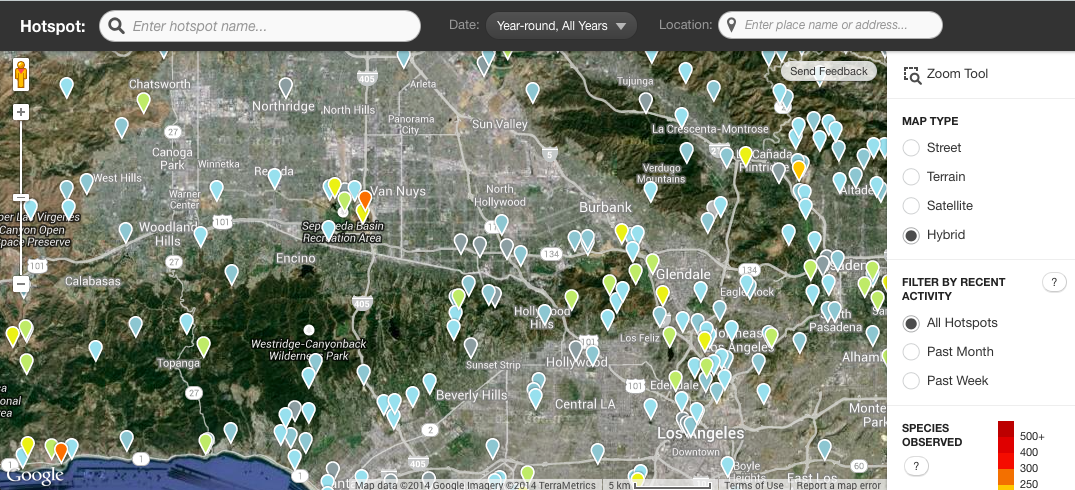
Using the Explore Hotspots tool, you can type in a specific location like “Los Angeles” and see a large map with colored markers indicating the number of species in each location(the closer to red, the better). This will help you look at various areas for the best place to see a large number of bird species. Clicking on any of the markers will open a page that shows the number of species reported there, recent sightings, as well as top birders.
I always recommend looking at this page to see the recently-seen species at any new place before you go birding there for the first time, so you know what to expect or you can learn how to identify any birds you may not be familiar with.
Range & Point Maps
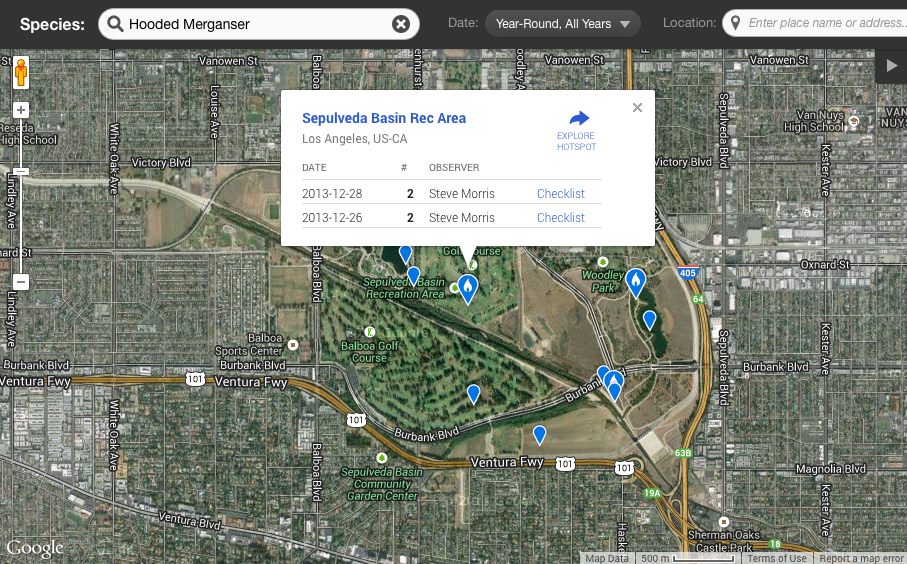
If you are on the quest to see a specific species, the first place you should look is the Range & Point Map. On this page you’ll see a search field that lets you type in a species name. You can then pan around the map until you see a hotspot where that bird has been reported. Red markers indicate the bird was spotted there in the last 30 days, blue markers for any time past that.
I had no idea about this feature until months after I started birding when someone told me about it. If I had known about this feature, I wouldn’t have driven an hour and a half to Lancaster to see a Hooded Merganser! The Range and Point map would have told me I only needed to go to Encino to see this striking bird.
Bar Charts
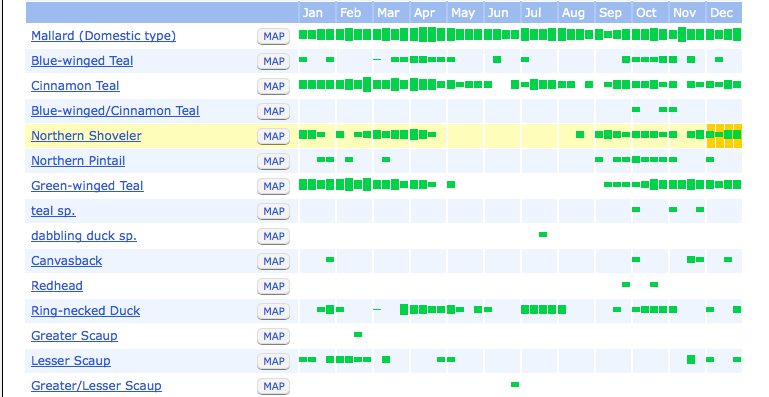
Bar Charts are a birder’s crystal ball. These charts are super useful if you want to see what species to look out for a during different times of the year. I’d recommend looking at a bar chart for either an entire state, or by using the hotspot list bar charts. If you try to pick super specific location, there usually isn’t enough info to generate a proper chart.
Now you know where to go see birds. Time to go out and see your very ‘first’ birds!
Report Your Observations
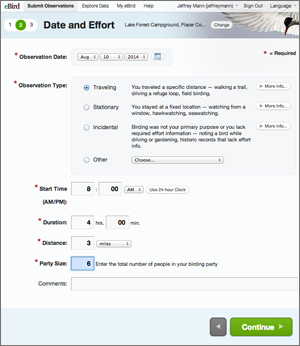 I recommend taking a phone, a small notebook, or a very detailed memory along with you on your bird outings. This way you can keep a complete list of which species you see on your walk. When you return home, log onto eBird and choose Submit Observations. From there, click Find it on a Map and enter your state or county where you birded; then you will be brought to the map page where you can can type in a specific location.
I recommend taking a phone, a small notebook, or a very detailed memory along with you on your bird outings. This way you can keep a complete list of which species you see on your walk. When you return home, log onto eBird and choose Submit Observations. From there, click Find it on a Map and enter your state or county where you birded; then you will be brought to the map page where you can can type in a specific location.
When choosing the precise spot for your report, you will usually see a few ‘hotspot’ markers showing commonly reported areas. You should choose the one that is at your park, canyon, beach, wherever you birded. Clicking on the marker will show the name of the location so you can see if it’s the correct spot. If no hotspot markers are visible or you birded from somewhere specific like your backyard, you can just click the map in the correct location, give the spot a name, and hit Continue.
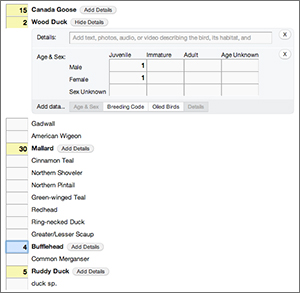 The following page is where you will give the details of your birding excursion. What time of day did you go? Did you walk around or stay in one spot? How long did you watch for? It takes just a moment to fill this out, then you get to the fun part—inputting your bird tally. As you look through this exhaustive list of birds, mark down any bird species you could correctly identify. If you were able to count the number of a particular species, enter it in its respective box. If you don’t remember how many birds there were, or there were too many to count, enter an ‘x’ in the box. eBird enables you to add details about each species. You can indicate gender, breeding code (e.g. birds in nest, displaying courtship behavior, recently fledged birds, etc., or if they were oiled (hopefully not!).
The following page is where you will give the details of your birding excursion. What time of day did you go? Did you walk around or stay in one spot? How long did you watch for? It takes just a moment to fill this out, then you get to the fun part—inputting your bird tally. As you look through this exhaustive list of birds, mark down any bird species you could correctly identify. If you were able to count the number of a particular species, enter it in its respective box. If you don’t remember how many birds there were, or there were too many to count, enter an ‘x’ in the box. eBird enables you to add details about each species. You can indicate gender, breeding code (e.g. birds in nest, displaying courtship behavior, recently fledged birds, etc., or if they were oiled (hopefully not!).
If you were unable to identify a particular bird, just leave it out, and eBird allows you to edit a submitted observation to add or change species if needed.
My eBird

Any time after you’ve entered your first observation into eBird, you can head to the My eBird page. This page displays your current life list count, breaking it up by life, month, and year. If you click any of the numbers on this page, you can see a list of species and sort it by location, name, and report date. I love to look at this page occasionally to see when I saw a certain bird for the first time, or what species I saw on my very first bird walk (at Ballona Wetlands).
Do you use eBird? What are your favorite features?
